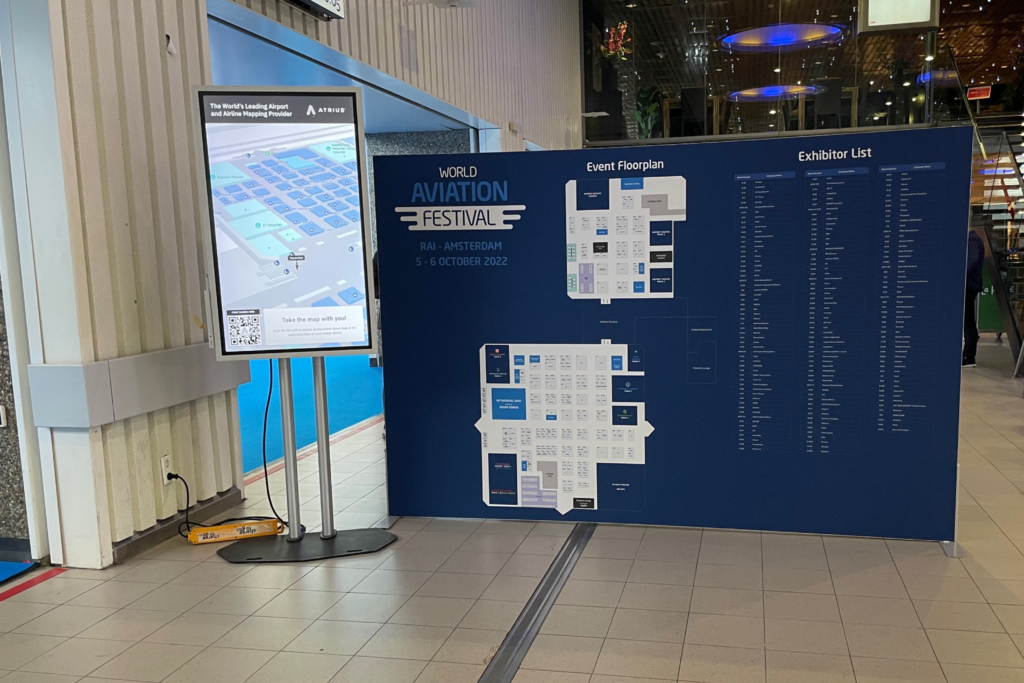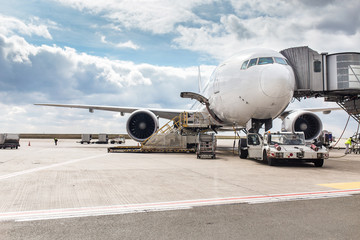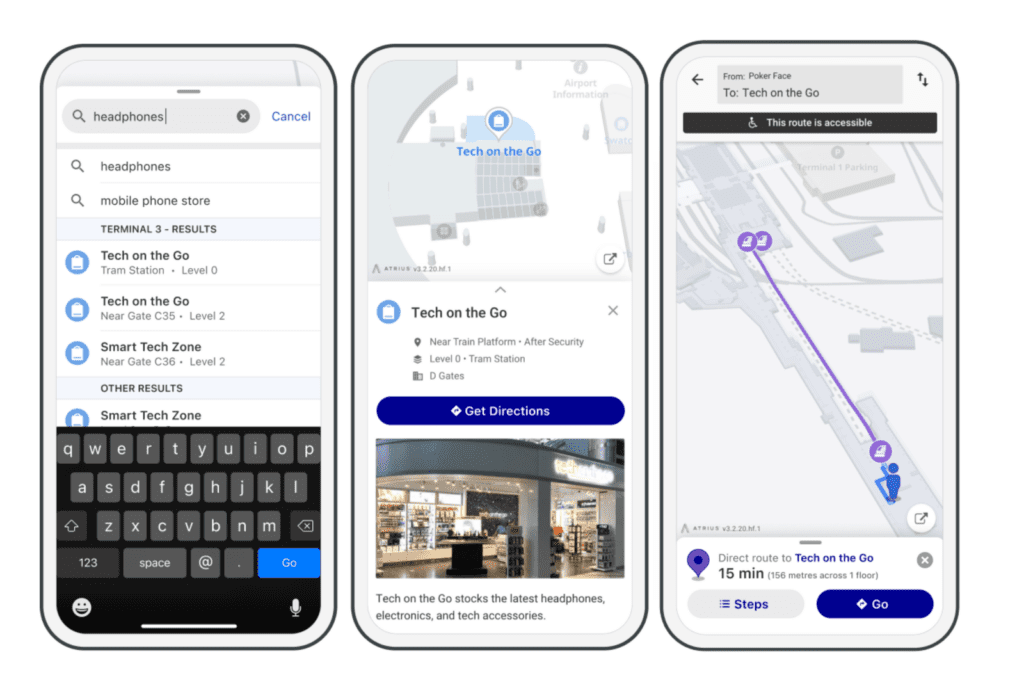Listening to the familiar “You’re now free to move about the aircraft” announcement reminded me how long we went without hearing those words. This past October, my colleagues and I headed to Amsterdam for the 2022 World Aviation Festival representing Atrius®, the official 2022 wayfinding solution for the festival. Every passenger journey touchpoint along the way showcased the differences between pre-pandemic and today’s new normal of air travel.
Being a part of the aviation industry, I recognize the changing consumer behaviors behind the increased competition for attention and travel dollars. In response, industry leaders are integrating technology to transform passenger experiences. We’re improving internal functions like operations, distribution, IT, and partnerships. We are also innovating customer-facing touchpoints like communication, service, marketing, loyalty, digital content, branded apps, and retailing.
“Welcome to Amsterdam, where the local time is…”
One safe flight and a quick adventure to the Rijksmuseum later, I met up with my international colleagues, Karlee and Olivier, at the conference. We were instantly delighted at the sight of 5,000+ attendees navigating their way around 112,000 square meters of meeting space with Atrius Wayfinder, discovering inspiring keynotes, roundtables, concessions, and sponsor booths throughout 22 conference rooms and 11 multi-functional halls in accurate, real-time walking directions.

Aviation experts and leaders sharing their unique perspectives on the new normal and traveler expectations included:
- Alison Taylor, Chief Customer Officer, American Airlines
- Jayne O’Brien, Head of Marketing and Loyalty, JetBlue
- Ryan Green, Senior Vice President and Chief Marketing Officer, Southwest Airlines
Our industry is hyper-focused on meeting passenger expectations. After listening to and connecting with inspiring aviation leaders, our team brought home insight on these four top-of-mind trends:
- Passenger experiences are mission critical
- Brand loyalty programs are flying higher
- Tech-driven experiences and self-service resources are taking off
- Sustainability is a journey, not a destination
Passenger experiences are mission critical
People are more thoughtful about where and how they travel, according to the 2022 American Express Global Travel Trends Report. If flying is the “how” and airports are the “where”, then airline and facility operators are simultaneously responsible for delivering positive passenger experiences.
Passengers want seamless and contactless travel days. They want easily accessible, accurate airport and airline information, and industry developers are responding by integrating their respective technologies. Collaborative solutions like self-serve, touch-free kiosks, and mobile food ordering are contributing to travelers having an overall more pleasant experience. As are the branded airline apps displaying flight information, departure gates, and airport points of interest marked on user-friendly digital maps. The evolving ecosystem is exciting and exactly what we need to meet our customers’ expectations.
As familiar as I am with the benefits of airline apps, like many travelers, I’m using mine even more now than during my pre-pandemic travel. It’s empowering to upgrade my seat or search airport concession locations from the palm of my hand. Even better, I’m exploring airports without worrying about getting lost and missing my flight. So, long before my plane goes wheels up, my airline is earning my loyalty by helping me have a positive experience on the ground.
Brand loyalty programs are flying higher
Developing customer loyalty is complicated, in part because the inherent variables of air travel eventually affect every airline and all passengers. Parking challenges, weather-related flight delays, or long security lines are beyond an airline’s control. Still, customers often blame any negative airport experience on their carrier.
Which is why operators are shifting from just improving singular touch points like check-in or boarding, to delivering a strong door-to-door customer journey From ticket purchase to exiting the destination airport, airlines are replacing memories of negative travel-day events with exclusive services and higher-tier perks.
American Airlines and Delta Air Lines are leveling up on their loyalty programs, especially to build brand loyalty among leisure travelers.
“We’re listening to our customers and constantly looking for opportunities to preserve and elevate the premium experience that they expect…”
Dwight James, Delta Senior Vice President of Loyalty & CEO, Delta Vacations
McKinsey & Company tells us leisure travel is exploding. Aiming to increase repeat business among these non-business travelers, Delta Air Lines and Starbucks recently linked their loyalty programs; now coffee drinkers have a good reason to fly Delta instead of a competitor. I’m attentively watching for similar alliances designed to build airline loyalty in new markets.

Tech-driven experiences and self-service resources are taking off
The 2022 World Aviation Festival exhibit halls housed the latest versions of familiar technologies. Automated passenger and baggage check-in along with gate–management software continues evolving while biometrics are slowly making their way into all types of security technology. Digital enhancements are everywhere.
Two years since the start of the pandemic, the aviation industry is engaged in the same digital revolution we watched transform retail in 2020. Seemingly overnight, points of sale moved from in-store to online. While the rate of change now is not happening as rapidly, based on the innovations I saw at the conference, aviation is eagerly embracing new technologies.
It starts with marketers encouraging travelers to download and use airline mobile apps. Developers are loading this software with data-driven solutions that enhance the customer journey and keep organizational brands consistently in front of travelers.
Centralized, app-based experiences are replacing contact check-in with modernized and expedited processes conducted in the airline app. And considering 50% of passengers in 2025 will be millennials and Gen Z, change is necessary. These generations expect automated, self-service touchpoints.
Air travelers 2023 can look forward to frictionless, personalized customer journeys. Self-tagging bag checks, digital identity screening, and wayfinding technologies displaying location-specific coupons in airport apps. Providers collect valuable data points while passengers gain some control over their travel day.

Sustainability is a journey, not a destination
As anticipated, sustainability was a popular topic of formal presentation and casual conversation at World Aviation Festival. Aviation is fully committed to achieving net zero emissions while meeting various requirements on reporting standardization and disclosure.
I’m proud to say U.S. aviation partners are slowly but steadily making the meticulous improvements required to meet state and federal sustainability guidelines. The industry continues to understand the importance of emissions tracking while learning how to track, measure, and report on progress. Renovations and new buildings incorporate environmentally-friendly designs that allow sustainable operations well into the future. Operators are identifying and getting quick wins like improving water and energy conservation even in older airports and adjacent operations. Dallas Fort Worth International Airport (DFW) for example, is training employees at program implementation and promoting ways travelers can support airport sustainability initiatives.
The airline side of our industry is responding to the call for sustainable operations as well. For example, JetBlue Ventures is experimenting with a one-pilot-four-passenger zero-emissions vehicle. United Airlines recently placed a $100 million down payment on zero-emission urban air mobility (UAM) vehicles, also known as flying taxis.
And finally, the passengers our industry welcomes and serves are willing partners in our sustainability journeys. A recent survey found 78% of respondents want to positively impact the places they’re visiting, essentially solidifying the role that sustainability has on the future of travel.
Proactively making up for lost time (and flights)
With COVID-19 no longer dictating the need for reactive operations, keynote speakers, session leaders, and exhibitors presented from a much-welcomed proactive perspective.
Aviation partners are sprinting toward 2023 enthusiastically and optimistically. Hopefully the emerging passenger-facing solutions, omnichannel communications, greener travel, and more accessible customer experiences are the new aviation reality.
And while I can’t predict specifics for aviation operations in 2023, I can promise you Atrius has the wayfinding technologies you and our other airline and airport partners need to optimize the traveler journey.

Looking back on the trip, the 2022 World Aviation Festival was energizing, insightful, and refreshing. We had a jam-packed three days filled with great conversations. It was great catching up with industry friends, old and new in Amsterdam!



